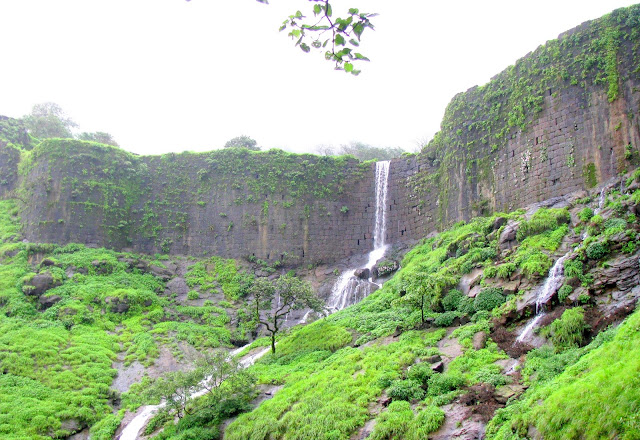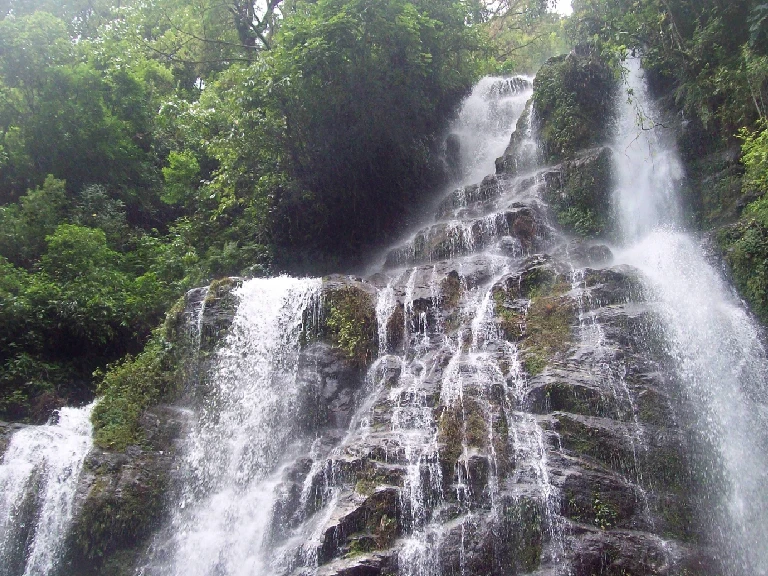Once upon a time, in the Sahyadris (Chapter 2/3 : Downpour)
Ethereal clouds had descended on these bleeding green hills – and wherever you looked, was a moving film of heavenly delusion, floating by in a wet, watery world of magic. Precipitation seemed to have taken a new form, combining heavy grey, nimbus clouds with swirls of fog and mist, surrounding us mortals in arcane, other-worldliness, warning us perhaps, that we had intruded into the realm of the rain-fairies. Yet, blocks of hand-cut stones, mossed up with incessant rains, formed man-made bulwark walls, reminding us that this was once a bastion of the mortals indeed. Not far away, a slow-moving cable car brought us back to the modern world, albeit for seconds, as the cabin ascended and disappeared in the thick swirling wisps of a monsoonal Bermudan triangle.
This was Raigad, once the capital of the Marathas - perhaps the last empire of power in the subcontinent. Centuries back, they had hacked at the foundations of the Mughal empire, conquering their way even up to faraway Bengal (instilling fear as the marauding borgis) and even challenging the might of the British. 800m above sea level, this 2000 step chapter in history is just a couple of hours from Mumbai. And is one of a multitude of fortresses that cling to the hill tops of the Sahyadri – Torna, Shivneri, Pratapgad, Sinhagad, the list is long, very long. Once, these fortresses used to shudder with the thunder of the thousands of cavalry stationed here, awaiting war, surveying the undulating lands of the Western Ghats. Today, like every single lesson in history, the last pages of the book of the Marathas has but the silent shells of the empty fortresses, as nature claws its way back, step by step, wall by wall.
Yet, as you walk by, the stones will whisper with the tales of the past, some credible, others legendary – trained monitor lizards climbing these vertiginous walls to transport trespassers, milkmaids climbing down the steep staircases in the darkest of nights impressing the Chattrapati himself, and many more. Outside these esoteric stories, history lies in derelict ruins. But despite these ruins, the fortresses are not forlorn. Thousands of travellers climb these fortresses, come rain or sun. For some, it is drinking from the urn of history, for others it is a re-invigoration of the sentiments of nationalism. And for many more, it is an intoxication that comes alive in the months of the monsoon, forging memories that are as unforgettable as they are irreplaceable.
As I turn back the pages of my Mumbai
memoirs, I smile as I recollect these days of intoxication. When we would seek
out the wettest weekends to chase the clouds. And the rains. There were a few
simple obligations that had to be met – monsoons meant we had to head to the
hills, and never the beaches, we had to walk in the clouds, and of course, we
had to get drenched. Hot chai and pakoda were a bonus. And if you could splash in
those ephemeral waterfalls – proof that the hills were brought back to life,
with the water coursing in their veins – the pluviometer would overflow in
ecstatic insanity. Life was demanding indeed. The clouds were not enough – you had
to stamp your existence in its downpour. And that we did, in plenty. Scaling
many a hill, mounting many a fortress, slipping umpteen times on the stairways
to heaven tumbling with rainfall, walking under curtains of waterfalls,
crossing torrents gushing out of sluices, to finally scale the peak and be lost
in a cloud-opia of wonders.
At the fortress top, almost always, everyone
would turn inwards, solemn, silent, and stoical. Perhaps, it was the winds that
would whistle with a voice of its own. Perhaps it was the sense of closure at
the top of an arduous trek that would make people ask subliminally, what next
after the top. Perhaps it would be the statue of Shivaji, that would stare back,
like an Ozymandiaz, pensive and lost in the meaning of existence. Or perhaps,
it would be the rains, that would make the pilgrim feel drenched, dishevelled,
and deranged. And yet, at the bottom of those rundown feelings, create a sense
of euphoria and ebullience, showing that a circularity alone has meaning in a meaningless
world.
There, at the top, it would be all clouds and mists
and rains. If there was any chink in that cloudy armour, you could see the vast
expanse of the lands below – bathed in lemony, lime greenery, and complemented
with the blues of large lakes and the orange-red tiles of the distant villages.
Sometimes, we would even witness a wonder reserved for the hillscaped eyes – a waterfall
gushing upwards from the wall of a fortress, thanks to convection winds overpowering
the waters and gushing the flow upwards. Talk about a water-rise, not a
waterfall!
The climb down to terra-firma would
be accompanied by a change in dry clothes (we would go prepared) and where available,
tea and piping hot fritters, and even roasted corn, massaged vigorously with
lemon and chilli powder. On the way back, we would often stop by the banks of the
lakes, to allow a pale ruddy sunset to further sprinkle a bit of silent introspection
after an already- heady day. A Lucky Ali or an Atif would be piping softly from
our car stereo…Kahan se ye hawa aayi / Ghataayen kaali kyoun chhaayi…
Another day in the rain-washed abundance of
the hills. Another diary entry - indelible, melancholic, written on the clouds,
some words destined to float and wander faraway, others to spiral back to the
hills, only to be picked up by yet another wayfarer some other day…





Comments
Post a Comment